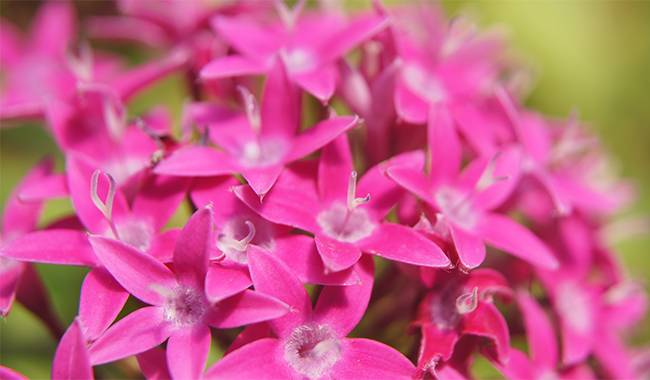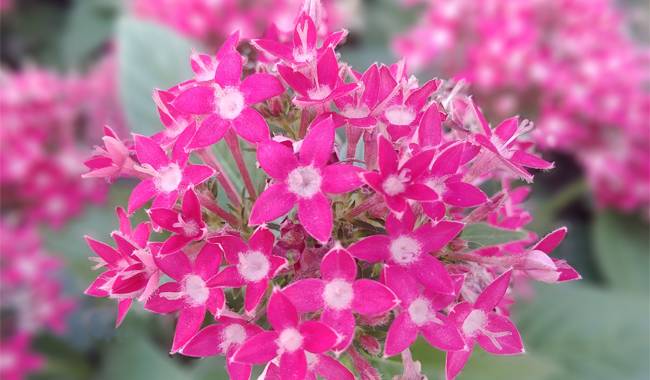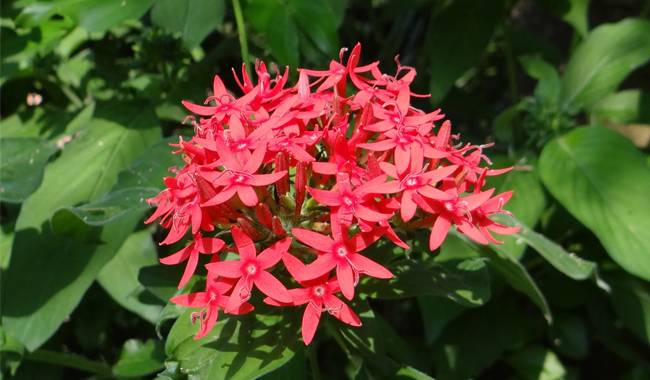
The brilliant appearance of Pentas lanceolata in every sense of the word has turned this plant, chosen for the few, into a favorite of amateur florists. For some reason, it has become a rival to the widely known geranium, although they are quite different crops in terms of whimsy. Visually, Pentas lanceolata’s bright green leaves and bright star-shaped flowers are a favorite of almost everyone. But this cannot be said of the plant’s characteristics. No matter how advertised, they will not be an easy plant to grow. They do not forgive mistakes with high requirements for light, temperature, watering, and air humidity. You will learn how to grow Pentas lanceolata in ThumbGarden’s article.
PENTAS LANCEOLATA PLANT DESCRIPTION
Pentas lanceolata looks like exemplary herbaceous perennials, and in terms of the brightness of their blooms, they easily eclipse the beauty of the most eye-catching annuals. Their soft leaves beckon with their special hairs and texture, while the blooms are unforgettable. But this plant is not as simple as it first appears. pentas lanceolata is now being hailed as a fashionable new thing to grow from seed for the home and garden, forgetting that the Egyptian star was an exclusive plant until a few years ago.
The Pentas lanceolata representatives in the room are compact hybrid Pentas lanceolata varieties. These lush indoor shrubs can also be grown as garden plants (annuals or overwintered indoors). They most commonly form compact clumps 12-20 inches (30-50 cm) tall. Pentas lanceolata’s straight, stiff shoots branch densely and are hardly bare underneath with proper care and bend well. The leaves are large, up to 2.5 inches (6.5 cm), strongly pointed, elliptic-lanceolate, pubescent, and beautifully rugose, provided by delicate veins. Pentas lanceolata features the most beautiful and striking cool-toned, emerald green color.
The top hemisphere of the inflorescence – a dense umbel – is dazzlingly bright. With a diameter of up to 4 inches (10 cm), they look large and airy at the same time. The small, star-shaped Pentas lanceolata flowers have a very slender tube that gives the inflorescence an unusual elegance and airiness.
The flowering period of Pentas lanceolata lasts almost all year and is easily changed depending on conditions and care. Pentas lanceolata is suitable for decorating in autumn and winter but does not lose charm in the warmer months. Pentas lanceolata’s dazzling white-pink-purple tones seem surprisingly appropriate in winter and are very distinctive. The cool tones of the foliage and the pure tones of the acrylic inflorescence look like an explosion of color.
It’s best to choose Pentas lanceolata based on the color of the inflorescence. All varieties have similar foliage, but choose plants with white, bright pink, red, red with white eyes, and purple inflorescences so you can find the perfect accent for your interior.
GROWING CONDITIONS FOR INDOOR PENTAS LANCEOLATA

The light-loving nature of Pentas lanceolata can only compete with its heat-loving nature. However, the predictable comfort of indoor conditions for the plant does not mean that there are no pitfalls of its own when choosing the ideal location for Pentas lanceolata.
Lighting and Placement
Pentas lanceolata does not like direct sunlight but is generally very fond of light. It is worth finding a bright, diffused light protected from scorching sunlight. An ideal reference point is the eastern bay window. Move plants inside only in very bright rooms near south-facing windows. However, Pentas lanceolata should only be placed on a windowsill in summer.
Pentas lanceolata reacts extremely painfully to any lack of light. It quickly begins to elongate, takes a problematic and very long time to recover its shape, and is unsuitable for strict shaping. To avoid the unfortunate consequences of elongation, the first signs (fading of color) should be taken into account during regular inspections.
Compensating the seasonal decrease of light is a must for Pentas lanceolata.
Temperature and ventilation
Even in winter, the minimum temperature for Pentas lanceolata is 59 °F (15°C). It prefers stable temperatures, does not mind a slight drop in temperature at night, and is not very tolerant of high temperatures (especially when humidity is low). For Pentas lanceolata inside the house, find a “quiet” warm place where constant contact and change will not affect the plant.
Pentas lanceolata prefer fresh air and frequent ventilation. They can be moved into the fresh air and out of direct sunlight in summer. pentas lanceolata is not sensitive to ventilation (no sudden changes in temperature). Excessive coldness during ventilation, heaters and air conditioning is one of the main causes of the rapid loss of decorative properties of Pentas lanceolata.
CARING FOR PENTAS LANCEOLATA AT HOME

The beauty of healthy shrubs in bloom can only be enjoyed if they are well cared for. Pentas lanceolata will suffer if they are not properly cared for.
Watering and air humidity
Pentas lanceolata is very sensitive to the dryness of the soil. Prolonged drought usually has irreversible consequences, and insufficient moisture during flowering can cause sudden death.
Ideally, Pentas lanceolata should be kept evenly moist, allowing the top layer of soil to dry out. Even in winter, do not allow the substrate to dry out too much; simply increase the watering interval by 1-2 days and reduce the amount of water. Drain the tray immediately in winter and after 5 minutes in summer.
Pentas lanceolata prefers high humidity. Pentas lanceolata will bloom most beautifully if you choose the right location from a room with high humidity or a room running a humidifier. You can place trays of moist expanded clay or pebbles for the plants, but if this is not possible, you should still try to raise the humidity level by spraying frequently (with a fine spray, without getting the buds and flowers wet).
Only rainwater or similar soft water is suitable for Pentas lanceolata. the temperature should be matched to the air in the room.
Nutrients and fertilizer composition
Nutrients for Pentas lanceolata should be determined by the flowering period and the length of the flowering period. If the plant is not tired and does not flower during the coldest months, fertilize in the fall and winter – but less frequently, 1.5 times a month (from October to February). After flowering, fertilization should be stopped and restarted at the first signs of growth. During active vegetation and flowering, the frequency of fertilization is once every two weeks.
Use a general-purpose fertilizer for beautiful flowering plants. A balance of micronutrients is important for this plant, so pure fertilizers containing only nitrogen, potassium, and phosphorus are not suitable.
Pruning and shaping Pentas lanceolata
In order to prolong the flowering time of the plant, it is necessary to remove faded inflorescences in time to stimulate the growth of other buds and cause new fluctuations.
Basic pruning of Pentas lanceolata is carried out between or after the flowering waves. All shoots are shortened to the desired height, leaving at least 2-3 buds, but usually aiming for a height of 12-20 inches (30-50 cm). A simple, frequent pruning process, if done in due time, dispenses with classic pruning and maintains the plant’s height. Pentas lanceolata can be pinched until flower buds appear at the top of the shoots.
Repotting, containers, and substrates
Pentas lanceolata can be cultivated as perennials or annuals and replaced with new cuttings or seedlings. Repotting of perennials should be done annually. The classical method is also ideal for Pentas lanceolata. This plant should be transplanted in late February or March before daylight begins to grow and the plant is inactive vegetation. Any universal, loose substrate can be used for Pentas lanceolata. high drainage in the bottom of the container is mandatory.
Pests and problems in cultivation
Pentas lanceolata is susceptible to lack of light, incorrect nutrients and fluctuations in substrate moisture, slow growth or stretching, often partial loss of foliage, and unpleasantly rapid loss of its characteristic color.
Insect pests include aphids and spider mites, treated immediately with insecticides. The only disease threatening Pentas lanceolata is rot, which requires urgent drying of the root ball or replanting (inevitable loss of ornamental value and the need for renovation).
SPREAD OF PENTAS LANCEOLATA
Seeds of the original Pentas lanceolata species are becoming increasingly available, but this fascinating plant’s main method of propagation is still cuttings. All types of Pentas lanceolata can be cut – stem and shoot cuttings from semi-dormant and young shoots. The main thing is that the twigs should not have time to form flower buds. Root Pentas lanceolata cuttings under greenhouse conditions in any loose, slightly moist substrate at room temperature.
Pentas lanceolata seeds are sown like the usual summer flowering seedlings – in spring, uncovered, in light soil, and a general container, under film or glass. Bright light, light humidity, and steady heat – that’s all the seedlings need. As the root system becomes established and previous containers are filled, these plants will be clamped and transplanted. It’s best to start early.







